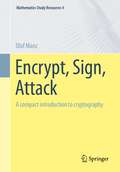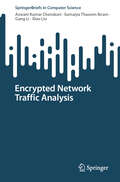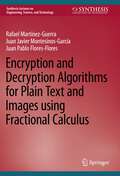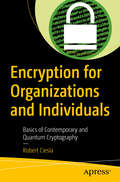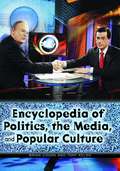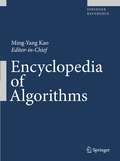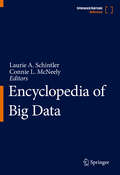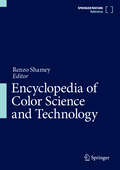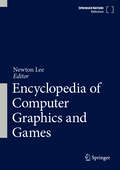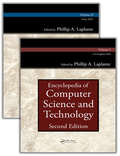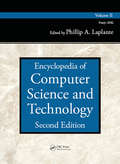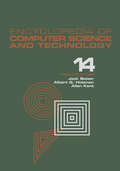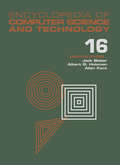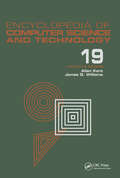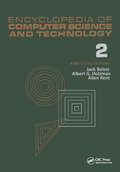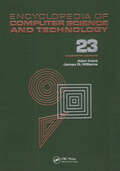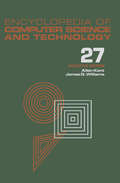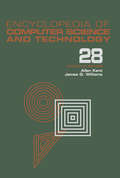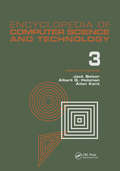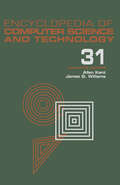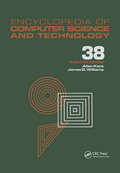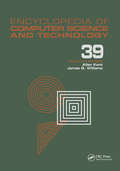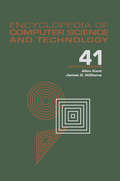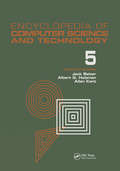- Table View
- List View
Encrypt, Sign, Attack: A compact introduction to cryptography (Mathematics Study Resources #4)
by Olaf ManzThis book explains compactly, without theoretical superstructure and with as little mathematical formalism as possible, the essential concepts in the encryption of messages and data worthy of protection. The focus is on the description of the historically and practically important cipher, signature and authentication methods. Both symmetric encryption and public-key ciphers are discussed. In each case, the strategies used to attack and attempt to "crack" encryption are also discussed. Special emphasis is placed on the practical use of ciphers, especially in the everyday environment. The book is suitable for working groups at STEM schools and STEM teacher training, for introductory courses at universities as well as for interested students and adults.
Encrypted Email
by Hilarie OrmanThis SpringerBrief examines the technology of email privacy encryption from its origins to its theoretical and practical details. It explains the challenges in standardization, usability, and trust that interfere with the user experience for software protection. Chapters address the origins of email encryption and why email encryption is rarely used despite the myriad of its benefits -- benefits that cannot be obtained in any other way. The construction of a secure message and its entwining with public key technology are covered. Other chapters address both independent standards for secure email and how they work. The final chapters include a discussion of getting started with encrypted email and how to live with it. Written by an expert in software security and computer tools, Encrypted Email: The History and Technology of Message Privacy is designed for researchers and professionals working in email security and encryption. Advanced-level students interested in security and networks will also find the content valuable.
Encrypted Network Traffic Analysis (SpringerBriefs in Computer Science)
by Xiao Liu Gang Li Aswani Kumar Cherukuri Sumaiya Thaseen IkramThis book provides a detailed study on sources of encrypted network traffic, methods and techniques for analyzing, classifying and detecting the encrypted traffic. The authors provide research findings and objectives in the first 5 chapters, on encrypted network traffic, protocols and applications of the encrypted network traffic. The authors also analyze the challenges and issues with encrypted network traffic. It systematically introduces the analysis and classification of encrypted traffic and methods in detecting the anomalies in encrypted traffic. The effects of traditional approaches of encrypted traffic, such as deep packet inspection and flow based approaches on various encrypted traffic applications for identifying attacks is discussed as well. This book presents intelligent techniques for analyzing the encrypted network traffic and includes case studies. The first chapter also provides fundamentals of network traffic analysis, anomalies in the network traffic, protocols for encrypted network traffic. The second chapter presents an overview of the challenges and issues with encrypted network traffic and the new threat vectors introduced by the encrypted network traffic. Chapter 3 provides details analyzing the encrypted network traffic and classification of various kinds of encrypted network traffic. Chapter 4 discusses techniques for detecting attacks against encrypted protocols and chapter 5 analyzes AI based approaches for anomaly detection. Researchers and professionals working in the related field of Encrypted Network Traffic will purchase this book as a reference. Advanced-level students majoring in computer science will also find this book to be a valuable resource.
Encryption and Decryption Algorithms for Plain Text and Images using Fractional Calculus (Synthesis Lectures on Engineering, Science, and Technology)
by Rafael Martínez-Guerra Juan Javier Montesinos-García Juan Pablo Flores-FloresThis book offers an alternative for encrypting and decrypting messages using objects called integer and fractional-order estimators or observers, by means of security codes. The authors first establish the class of observers capable of carrying out this work. Then, the type of observers to treat either the integer or fractional order type and their main characteristics is mentioned. The book also presents an essential property of some systems such as Liouville, which is vital for the encryption and decryption of messages in integer and fractional order nonlinear systems by using the synchronization property of chaotic systems. Finally, it addresses some logistic maps such as Mandelbrot sets including Julia and fractal sets, taking advantage of their characteristics to encrypt or recover messages.
Encryption for Organizations and Individuals: Basics of Contemporary and Quantum Cryptography
by Robert CieslaCryptography and encryption aren't just for geeks and spies—they’re also part of our daily lives. This book enlightens you with the basics of digital cryptography and covers the must-do practices organizations need to implement when it comes to fending off data theft and eavesdroppers. You will uncover the concepts of digital encryption and examine key digital encryption algorithms and their various applications. Gauging cryptography from an enterprise perspective, you will get an in-depth look at common attacks that can occur in your systems and lean how to counter themMoving on to quantum computing, you will discover how it differs from the current computing paradigm and understand its potential for the future. After clearing the basics, you will take a close look at how quantum computers work in practice. Shifting focus to quantum cryptography, you will learn more about quantum key distribution (QKD) and how it differs from present-day encryption methodologies. You will also consider the current implementations of QKD, including distribution systems by SwissQuantum and QKD-distribution networks provided by the DARPA Quantum Network. Ultimately, you will learn the means of defending against cryptographic attacks in the up-and-coming quantum age, such as utilizing zero-knowledge proof (ZKP) systems.Deepen your knowledge of cryptographic concepts and be introduced to the new paradigm of quantum cryptography with this book. What You Will LearnAppreciate how digital encryption algorithms workSecure your infrastructure from cryptographic attacksUnderstand the basics of quantum information scienceDiscover how cryptography relates to quantum computingImplement Quantum Key Distribution (QKD) Who This Book Is ForThis book is aimed at readers who have an interest in both well-established and up-and-coming types of cryptography, as well as members of organizations to whom privacy is a top priority.
Encyclopedia Of Politics, The Media, And Popular Culture
by Tony Kelso Brian A. CoganMedia in this country has helped shaped culture, which has affected politics, which in turn has influenced how those same media behave. The inter-relatedness of these societal elements is distinctive. Part I of this book is thematically organized by chapter examining these relationships from both a historical and contemporary perspective. Part II presented alphabetically arranged entries for people, programs, and events related to these subjects. The book succeeds at being a handy reference work, or just a fun volume to peruse. Annotation c2010 Book News, Inc., Portland, OR (booknews.com)
Encyclopedia of Algorithms
by Ming-Yang KaoOne of Springer's renowned Major Reference Works, this awesome achievement provides a comprehensive set of solutions to important algorithmic problems for students and researchers interested in quickly locating useful information. This first edition of the reference focuses on high-impact solutions from the most recent decade, while later editions will widen the scope of the work. All entries have been written by experts, while links to Internet sites that outline their research work are provided. The entries have all been peer-reviewed. This defining reference is published both in print and on line.
Encyclopedia of Big Data
by Connie L. McNeely Laurie A. SchintlerThis encyclopedia will be an essential resource for our times, reflecting the fact that we currently are living in an expanding data-driven world. Technological advancements and other related trends are contributing to the production of an astoundingly large and exponentially increasing collection of data and information, referred to in popular vernacular as “Big Data.” Social media and crowdsourcing platforms and various applications ― “apps” ― are producing reams of information from the instantaneous transactions and input of millions and millions of people around the globe. The Internet-of-Things (IoT), which is expected to comprise tens of billions of objects by the end of this decade, is actively sensing real-time intelligence on nearly every aspect of our lives and environment. The Global Positioning System (GPS) and other location-aware technologies are producing data that is specific down to particular latitude and longitude coordinates and seconds of the day. Large-scale instruments, such as the Large Hadron Collider (LHC), are collecting massive amounts of data on our planet and even distant corners of the visible universe. Digitization is being used to convert large collections of documents from print to digital format, giving rise to large archives of unstructured data. Innovations in technology, in the areas of Cloud and molecular computing, Artificial Intelligence/Machine Learning, and Natural Language Processing (NLP), to name only a few, also are greatly expanding our capacity to store, manage, and process Big Data. In this context, the Encyclopedia of Big Data is being offered in recognition of a world that is rapidly moving from gigabytes to terabytes to petabytes and beyond. While indeed large data sets have long been around and in use in a variety of fields, the era of Big Data in which we now live departs from the past in a number of key respects and with this departure comes a fresh set of challenges and opportunities that cut across and affect multiple sectors and disciplines, and the public at large. With expanded analytical capacities at hand, Big Data is now being used for scientific inquiry and experimentation in nearly every (if not all) disciplines, from the social sciences to the humanities to the natural sciences, and more. Moreover, the use of Big Data has been well established beyond the Ivory Tower. In today’s economy, businesses simply cannot be competitive without engaging Big Data in one way or another in support of operations, management, planning, or simply basic hiring decisions. In all levels of government, Big Data is being used to engage citizens and to guide policy making in pursuit of the interests of the public and society in general. Moreover, the changing nature of Big Data also raises new issues and concerns related to, for example, privacy, liability, security, access, and even the veracity of the data itself.Given the complex issues attending Big Data, there is a real need for a reference book that covers the subject from a multi-disciplinary, cross-sectoral, comprehensive, and international perspective. The Encyclopedia of Big Data will address this need and will be the first of such reference books to do so. Featuring some 500 entries, from "Access" to "Zillow," the Encyclopedia will serve as a fundamental resource for researchers and students, for decision makers and leaders, and for business analysts and purveyors. Developed for those in academia, industry, and government, and others with a general interest in Big Data, the encyclopedia will be aimed especially at those involved in its collection, analysis, and use. Ultimately, the Encyclopedia of Big Data will provide a common platform and language covering the breadth and depth of the topic for different segments, sectors, and disciplines.
Encyclopedia of Color Science and Technology
by Renzo ShameyThis fully revised and expanded 2nd edition provides a single authoritative resource describing the concepts of color and the application of color science across research and industry. Significant changes for the 2nd edition include: New and expanded sections on color engineeringMore entries on fundamental concepts of color science and color termsMany additional entries on specific materialsFurther material on optical concepts and human visual perceptionAdditional articles on organisations, tools and systems relevant to colorA new set of entries on 3D presentation of color In addition, many of the existing entries have been revised and updated to ensure that the content of the encyclopedia is current and represents the state of the art. The work covers the full gamut of color: the fundamentals of color science; the physics and chemistry; color as it relates to optical phenomena and the human visual system; and colorants and materials. The measurement of color is described through entries on colorimetry, color spaces, color difference metrics, color appearance models, color order systems and cognitive color. The encyclopedia also has extensive coverage of applications throughout industry, including color imaging, color capture, display and printing, and descriptions of color encodings, color management, processing color and applications relating to color synthesis for computer graphics are included. The broad scope of the work is illustrated through entries on color in art conservation, color and architecture, color and education, color and culture, and biographies of some of the key figures involved in color research throughout history. With over 250 entries from color science researchers across academia and industry, this expanded 2nd edition of the Encyclopedia of Color Science and Technology remains the most important single resource in color science.
Encyclopedia of Computer Graphics and Games
by Newton LeeEncyclopedia of Computer Graphics and Games (ECGG) is a unique reference resource tailored to meet the needs of research and applications for industry professionals and academic communities worldwide. The ECGG covers the history, technologies, and trends of computer graphics and games.EditorNewton Lee, Institute for Education, Research, and Scholarships, Los Angeles, CA, USA Academic Co-ChairsShlomo Dubnov, Department of Music and Computer Science and Engineering, University of California San Diego, San Diego, CA, USAPatrick C. K. Hung, University of Ontario Institute of Technology, Oshawa, ON, CanadaJaci Lee Lederman, Vincennes University, Vincennes, IN, USAIndustry Co-ChairsShuichi Kurabayashi, Cygames, Inc. & Keio University, Kanagawa, JapanXiaomao Wu, Gritworld GmbH, Frankfurt am Main, Hessen, Germany Editorial Board MembersLeigh Achterbosch, School of Science, Engineering, IT and Physical Sciences, Federation University Australia Mt Helen, Ballarat, VIC, AustraliaRamazan S. Aygun, Department of Computer Science, Kennesaw State University, Marietta, GA, USABarbaros Bostan, BUG Game Lab, Bahçeşehir University (BAU), Istanbul, TurkeyAnthony L. Brooks, Aalborg University, Aalborg, DenmarkGuven Catak, BUG Game Lab, Bahçeşehir University (BAU), Istanbul, TurkeyAlvin Kok Chuen Chan, Cambridge Corporate University, Lucerne, SwitzerlandAnirban Chowdhury, Department of User Experience and Interaction Design, School of Design (SoD), University of Petroleum and Energy Studies (UPES), Dehradun, Uttarakhand, IndiaSaverio Debernardis, Dipartimento di Meccanica, Matematica e Management, Politecnico di Bari, Bari, ItalyAbdennour El Rhalibi, Liverpool John Moores University, Liverpool, UKStefano Ferretti, Department of Computer Science and Engineering, University of Bologna, Bologna, ItalyHan Hu, School of Information and Electronics, Beijing Institute of Technology, Beijing, ChinaMs. Susan Johnston, Select Services Films Inc., Los Angeles, CA, USAChris Joslin, Carleton University, Ottawa, CanadaSicilia Ferreira Judice, Department of Computer Science, University of Calgary, Calgary, CanadaHoshang Kolivand, Department Computer Science, Faculty of Engineering and Technology, Liverpool John Moores University, Liverpool, UKDario Maggiorini, Department of Computer Science, University of Milan, Milan, ItalyTim McGraw, Purdue University, West Lafayette, IN, USAGeorge Papagiannakis, ORamaVR S.A., Heraklion, Greece; FORTH-ICS, Heraklion Greece University of Crete, Heraklion, GreeceFlorian Richoux, Nantes Atlantic Computer Science Laboratory (LINA), Université de Nantes, Nantes, FranceAndrea Sanna, Dipartimento di Automatica e Informatica, Politecnico di Torino, Turin, ItalyYann Savoye, Institut fur Informatik, Innsbruck University, Innsbruck, AustriaSercan Şengün, Wonsook Kim School of Art, Illinois State University, Normal, IL, USARuck Thawonmas, Ritsumeikan University, Shiga, JapanVinesh Thiruchelvam, Asia Pacific University of Technology & Innovation, Kuala Lumpur, MalaysiaRojin Vishkaie, Amazon, Seattle, WA, USADuncan A. H. Williams, Digital Creativity Labs, Department of Computer Science, University of York, York, UKSai-Keung Wong, National Chiao Tung University, Hsinchu, TaiwanEditorial Board InternSa
Encyclopedia of Computer Science and Technology
by Phillip A. LaplanteWith breadth and depth of coverage, the Encyclopedia of Computer Science and Technology, Second Edition has a multi-disciplinary scope, drawing together comprehensive coverage of the inter-related aspects of computer science and technology. The topics covered in this encyclopedia include: General and reference Hardware Computer systems organization Networks Software and its engineering Theory of computation Mathematics of computing Information systems Security and privacy Human-centered computing Computing methodologies Applied computing Professional issues Leading figures in the history of computer science The encyclopedia is structured according to the ACM Computing Classification System (CCS), first published in 1988 but subsequently revised in 2012. This classification system is the most comprehensive and is considered the de facto ontological framework for the computing field. The encyclopedia brings together the information and historical context that students, practicing professionals, researchers, and academicians need to have a strong and solid foundation in all aspects of computer science and technology.
Encyclopedia of Computer Science and Technology Volume II
by Phillip A. LaplanteThis book covers all aspects of computer science, engineering, and technology. It includes computer scientists, computer engineers computing professionals, managers, software professionals, and other technology professionals.
Encyclopedia of Computer Science and Technology: Volume 14 - Very Large Data Base Systems to Zero-Memory and Markov Information Source
by Allen Kent Jack Belzer Albert G. Holzman"This comprehensive reference work provides immediate, fingertip access to state-of-the-art technology in nearly 700 self-contained articles written by over 900 international authorities. Each article in the Encyclopedia features current developments and trends in computers, software, vendors, and applications...extensive bibliographies of leading figures in the field, such as Samuel Alexander, John von Neumann, and Norbert Wiener...and in-depth analysis of future directions."
Encyclopedia of Computer Science and Technology: Volume 16 - Index (Computer Science And Technology Encyclopedia Ser.)
by Jack Belzer""This comprehensive reference work provides immediate, fingertip access to state-of-the-art technology in nearly 700 self-contained articles written by over 900 international authorities. Each article in the Encyclopedia features current developments and trends in computers, software, vendors, and applications...extensive bibliographies of leading figures in the field, such as Samuel Alexander, John von Neumann, and Norbert Wiener...and in-depth analysis of future directions.
Encyclopedia of Computer Science and Technology: Volume 19 - Supplement 4: Access Technoogy: Inc. to Symbol Manipulation Patkages (Computer Science And Technology Encyclopedia Ser.)
by Allen Kent"This comprehensive reference work provides immediate, fingertip access to state-of-the-art technology in nearly 700 self-contained articles written by over 900 international authorities. Each article in the Encyclopedia features current developments and trends in computers, software, vendors, and applications...extensive bibliographies of leading figures in the field, such as Samuel Alexander, John von Neumann, and Norbert Wiener...and in-depth analysis of future directions."
Encyclopedia of Computer Science and Technology: Volume 2 - AN/FSQ-7 Computer to Bivalent Programming by Implicit Enumeration (Computer Science And Technology Encyclopedia Ser.)
by Jack Belzer"This comprehensive reference work provides immediate, fingertip access to state-of-the-art technology in nearly 700 self-contained articles written by over 900 international authorities. Each article in the Encyclopedia features current developments and trends in computers, software, vendors, and applications...extensive bibliographies of leading figures in the field, such as Samuel Alexander, John von Neumann, and Norbert Wiener...and in-depth analysis of future directions."
Encyclopedia of Computer Science and Technology: Volume 23 - Supplement 8: Approximation: Optimization, and Computing to Visual Thinking (Computer Science and Technology Encyclopedia)
by James G. Williams Allen Kent Carolyn M. Hall Rosalind Kent"This comprehensive reference work provides immediate, fingertip access to state-of-the-art technology in nearly 700 self-contained articles written by over 900 international authorities. Each article in the Encyclopedia features current developments and trends in computers, software, vendors, and applications...extensive bibliographies of leading figures in the field, such as Samuel Alexander, John von Neumann, and Norbert Wiener...and in-depth analysis of future directions."
Encyclopedia of Computer Science and Technology: Volume 27 - Supplement 12: Artificial Intelligence and ADA to Systems Integration: Concepts: Methods, and Tools
by Allen Kent"This comprehensive reference work provides immediate, fingertip access to state-of-the-art technology in nearly 700 self-contained articles written by over 900 international authorities. Each article in the Encyclopedia features current developments and trends in computers, software, vendors, and applications...extensive bibliographies of leading figures in the field, such as Samuel Alexander, John von Neumann, and Norbert Wiener...and in-depth analysis of future directions."
Encyclopedia of Computer Science and Technology: Volume 28 - Supplement 13: AerosPate Applications of Artificial Intelligence to Tree Structures (Computer Science And Technology Encyclopedia Ser.)
by Allen Kent"This comprehensive reference work provides immediate, fingertip access to state-of-the-art technology in nearly 700 self-contained articles written by over 900 international authorities. Each article in the Encyclopedia features current developments and trends in computers, software, vendors, and applications...extensive bibliographies of leading figures in the field, such as Samuel Alexander, John von Neumann, and Norbert Wiener...and in-depth analysis of future directions."
Encyclopedia of Computer Science and Technology: Volume 3 - Ballistics Calculations to Box-Jenkins Approach to Time Series Analysis and Forecasting (Computer Science And Technology Encyclopedia Ser.)
by Allen Kent Jack Belzer Albert G. Holzman"This comprehensive reference work provides immediate, fingertip access to state-of-the-art technology in nearly 700 self-contained articles written by over 900 international authorities. Each article in the Encyclopedia features current developments and trends in computers, software, vendors, and applications...extensive bibliographies of leading figures in the field, such as Samuel Alexander, John von Neumann, and Norbert Wiener...and in-depth analysis of future directions."
Encyclopedia of Computer Science and Technology: Volume 31 - Supplement 16: Artistic Computer Graphics to Strategic Information Systems Planning (Computer Science And Technology Encyclopedia Ser.)
by Allen Kent"This comprehensive reference work provides immediate, fingertip access to state-of-the-art technology in nearly 700 self-contained articles written by over 900 international authorities. Each article in the Encyclopedia features current developments and trends in computers, software, vendors, and applications...extensive bibliographies of leading figures in the field, such as Samuel Alexander, John von Neumann, and Norbert Wiener...and in-depth analysis of future directions."
Encyclopedia of Computer Science and Technology: Volume 38 - Supplement 23: Algorithms for Designing Multimedia Storage Servers to Models and Architectures (Computer Science And Technology Encyclopedia Ser.)
by Allen KentVolume 38 - Supplement 23: Algorithms for Designing Multimedia Storage Servers to Models and Architectures. Covering more than basic computer commands and procedures, this encyclopaedia summarizes how technology has developed, the future of computer programs and applications, and the significance of computer components. Following an introduction and overview, there are approximately 750 to 800 entries.
Encyclopedia of Computer Science and Technology: Volume 39 - Supplement 24 - Entity Identification to Virtual Reality in Driving Simulation
by Allen KentVolume 39 - Supplement 24 - Entity Identification to Virtual Reality in Driving Simulation. Covering more than basic computer commands and procedures, this encyclopaedia summarizes how technology has developed, the future of computer programs and applications, and the significance of computer components. Following an introduction and overview, there are approximately 750 to 800 entries.
Encyclopedia of Computer Science and Technology: Volume 41 - Supplement 26 - Application of Bayesan Belief Networks to Highway Construction to Virtual Reality Software and Technology (Computer Science And Technology Encyclopedia Ser.)
by Allen KentThis 41st volume covers Application of Bayesan Belief Networks to Highway Construction to Virtual Reality Software and Technology.
Encyclopedia of Computer Science and Technology: Volume 5 - Classical Optimization to Computer Output/Input Microform
by Allen Kent Jack Belzer Albert G. Holzman"This comprehensive reference work provides immediate, fingertip access to state-of-the-art technology in nearly 700 self-contained articles written by over 900 international authorities. Each article in the Encyclopedia features current developments and trends in computers, software, vendors, and applications...extensive bibliographies of leading figures in the field, such as Samuel Alexander, John von Neumann, and Norbert Wiener...and in-depth analysis of future directions."
